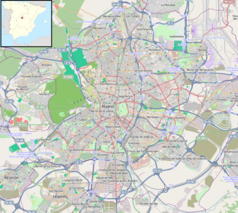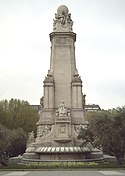Plaza de España (plac w Madrycie)
| ||
Pomnik Miguela Cervantesa, w tle wieżowiec Edificio de Espana | ||
| Państwo | ||
| Miejscowość | Madryt | |
| 40°25′24,21″N 3°42′44,04″W/40,423392 -3,712233 | ||
Plaza de España – jeden z najbardziej znanych i reprezentacyjnych placów w Madrycie. Znajduje się w dzielnicy Moncloa-Aravaca, w barrio administracyjnym Argüelles. Stanowi zakończenie reprezentacyjnej alei miasta, Gran Vía.
Historia
W XVII wieku w miejscu obecnego placu znajdowała się łąka Leganitos, której istnienie uwiecznił na łamach powieści Don Kichote z La Manchy pisarz Miguel de Cervantes y Saavedra. Następnie rozpoczęto budowę klasztoru, który w 1789 zburzono przed ukończeniem budowy. W XVIII i XIX w. leżący niedaleko Pałacu Królewskiego plac był miejscem, gdzie znajdował się garnizon wojskowy, a w miejscu klasztoru wybudowano koszary, które wyburzono w 1908. Wcześniej, na przełomie XIX i XX wieku, plac przyjął cywilny, reprezentacyjny charakter. W jego otoczeniu powstawały budynki rządowe, siedziby firm i apartamenty mieszkalne. Obecny wygląd plac uzyskał w połowie XX w. za dyktatury generała Franco, monumentalna zabudowa miała być dowodem faktu, że Hiszpania jest częścią nowoczesnego świata. Dwa najbardziej charakterystyczne budynki to:
- Edificio España - zbudowany w 1948 roku wieżowiec, który ma 107 metrów (26 pięter), basen usytuowany na jednej z najwyższych kondygnacji. W chwili budowy był najwyższym budynkiem w Madrycie.
- Torre de Madrid - powstały w 1957 roku wieżowiec, aż do 1988 był najwyższym budynkiem stolicy Hiszpanii (142 m - 37 pięter).
Na placu znajduje się też zrealizowany w latach 1925-1930 pomnik Miguela Cervantesa autora Don Kichota - sylwetki pisarza i głównych bohaterów jego najsłynniejszej powieści. Zaprojektowali go architekci Rafael Martínez Zapatero i Pedro Muguruza, a wyrzeźbił Lorenzo Coullaut Valera[1].
Przebudowa placu
Z końcem 2019 r. Rada Miasta Madrytu wyłoniła zwycięski projekt przebudowy placu. Realizacja zwycięskiej koncepcji "Welcome the Mother Nature" kosztować będzie 62 mln EUR, a jej rozpoczęcie planowane jest na luty 2020 r. Pierwszy etap prac, trwający do końca 2020 r., ma zmienić przestrzeń samego placu oraz jego połączenie z Gran Vía. Docelowo Plaza de España ma się stać terenem zielonym i pełnić funkcję łącznika Jardines de Sabatini i Parque de Oeste; planowana jest nasada ponad tysiąca nowych drzew. Natężenie ruchu drogowego w tym rejonie zostanie zdecydowanie zredukowane, powiększona zostanie strefa piesza. Wiązać się to będzie z rozbudową istniejącego już tunelu pod ulicą Bailén, co z powodu strategicznego jego położenia może wiązać się z poważnymi utrudnieniami komunikacyjnymi w tym obszarze[2].
Galeria
- (c) Carlos Delgado, CC BY-SA 3.0
Kamienna rzeźba Miguela de Cervantesa y Saavedry.
- (c) Carlos Delgado, CC BY-SA 3.0
Przypisy
- ↑ Annie Bennett "Madryt" Przewodnik National Geographic Wydawnictwo G+J RBA, National Geographic Society 2006 s. 54-55 ISBN 978-83-7596-187-4
- ↑ La remodelación de la Plaza de España empezará en febrero con un coste de 62 millones, idealista/news [dostęp 2020-01-02].
Media użyte na tej stronie
Autor: NordNordWest, Licencja: CC BY-SA 3.0
Location map of Spain
Equirectangular projection, N/S stretching 130 %. Geographic limits of the map:
- N: 44.4° N
- S: 34.7° N
- W: 9.9° W
- E: 4.8° E
Autor: Pedro A. Gracia Fajardo, escudo de Manual de Imagen Institucional de la Administración General del Estado, Licencja: CC0
Flaga Hiszpanii
Crossroads with a major road ahead.
Autor: David Adam Kess, Licencja: CC BY-SA 3.0
A Black and White Photo of the Cervantes Monument in Madrid Spain
the below text is from the english wikipedia
Plaza de España (or "Spain Square" in English) is a large square, and popular tourist destination, located in central Madrid, Spain, at the western end of the Gran Vía. It features a monument to Miguel de Cervantes Saavedra, and is bordered by two of Madrid's most prominent skyscrapers. Also, the Palacio Real (Royal Palace) is a short walk south from the plaza.
Cervantes Monument ------- In the center of the plaza is a monument to Spanish novelist, poet and playwright Miguel de Cervantes Saavedra, designed by architects Rafael Martínez Zapatero and Pedro Muguruza and sculptor Lorenzo Coullaut Valera. Most of the monument was built between 1925 and 1930. It was finished between 1956 and 1957 by Federico Coullaut-Valera Mendigutia, the son of the original sculptor.
The tower portion of the monument includes a stone sculpture of Cervantes, which overlooks bronze sculptures of Don Quixote and Sancho Panza. Next to the tower, there are two stone representations of Don Quixote's "true love", one as the simple peasant woman Aldonza Lorenzo, and one as the beautiful, imaginary Dulcinea del Toboso.Autor: רנדום, Licencja: CC BY-SA 3.0
Bronze statues of Don Quixote and Sancho Panza, at the Plaza de España in Madrid, Spain.
(c) Pan Camel at pl.wikipedia, CC-BY-SA-3.0
Pomnik Miguele Servantesa na Plaza de Espana w Madrycie
Stone statue of Aldonza Lorenzo sculpted by Federico Coullaut-Valera (1912–1989) in 1956–57. 2.90 metres high. Detail of the monument to Cervantes (1925–30, 1956–57) at the Plaza de España ("Spain Square") in Madrid. See also Dulcinea del Toboso (Don Quixote's idealization of Aldonza Lorenzo).
Autor: David Adam Kess, Licencja: CC BY-SA 3.0
A Black and White Photograph of a statue in Madrid, Spain consisting of Bronze sculptures of Don Quixote and Sancho Panza and photographed by David Adam Kess.
Autor: Luis García (Zaqarbal), Licencja: CC-BY-SA-3.0
North-eastern side of the monument to Miguel de Cervantes at the Plaza de España ("Spain Square") in Madrid (Spain).
(c) Carlos Delgado, CC BY-SA 3.0
Monument to Miguel de Cervantes, Madrid.
(c) Carlos Delgado, CC BY-SA 3.0
Monument to Miguel de Cervantes, Madrid.





















